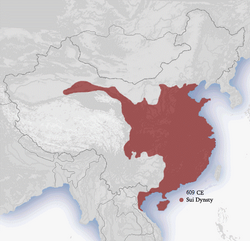
Back Sui-dinastie Afrikaans سلالة سوي الحاكمة Arabic Dinastía Sui AST Suy sülaləsi Azerbaijani سوئی سولالهسی AZB Суй династияһы Bashkir Суй Byelorussian Суей Bulgarian সুই সাম্রাজ্য Bengali/Bangla Tierniezh Sui Breton
Sui 隋 | |||||||||||||
|---|---|---|---|---|---|---|---|---|---|---|---|---|---|
| 581–618[a] | |||||||||||||
 Sui dynasty c. 609 | |||||||||||||
| Capital | Daxing (581–618) | ||||||||||||
| Common languages | Middle Chinese | ||||||||||||
| Religion | Buddhism, Taoism, Confucianism, Chinese folk religion, Zoroastrianism | ||||||||||||
| Government | Monarchy | ||||||||||||
| Emperor | |||||||||||||
• 581–604 | Emperor Wen | ||||||||||||
• 604–617 | Emperor Yang | ||||||||||||
• 617–618 | Emperor Gong | ||||||||||||
| Historical era | Post-classical era | ||||||||||||
• Ascension of Yang Jian | 4 March 581 | ||||||||||||
• Abolished by Li Yuan | 23 May 618[a] | ||||||||||||
| Area | |||||||||||||
| 589[1] | 3,000,000 km2 (1,200,000 sq mi) | ||||||||||||
| Currency | Chinese coin, Chinese cash | ||||||||||||
| |||||||||||||
| Today part of | |||||||||||||
| Sui dynasty | |||||||||||||||||||||||||||||||||||
|---|---|---|---|---|---|---|---|---|---|---|---|---|---|---|---|---|---|---|---|---|---|---|---|---|---|---|---|---|---|---|---|---|---|---|---|
"Sui dynasty" in Chinese characters | |||||||||||||||||||||||||||||||||||
| Chinese | 隋朝 | ||||||||||||||||||||||||||||||||||
| |||||||||||||||||||||||||||||||||||
| Part of a series on the |
| History of China |
|---|
The Sui dynasty ([swěɪ], pinyin: Suí cháo) was a short-lived Chinese imperial dynasty that ruled from 581 to 618. The re-unification of China proper under the Sui brought the Northern and Southern dynasties era to a close, ending a prolonged period of political division since the War of the Eight Princes. The Sui endeavoured to rebuild the country, re-establishing and reforming many imperial institutions; in so doing, the Sui laid much of the foundation for the subsequent Tang dynasty, who after toppling the Sui would ultimately preside over a new golden age in Chinese history.
The dynasty was founded by Yang Jian (Emperor Wen), who had been a member of the military aristocracy that had developed in the northwest during the prolonged period of division.[2] The Sui capital was initially based in Daxing (Chang'an, modern Xi'an), but later moved to Luoyang in 605, which had been re-founded as a planned city. Wen and his successor Emperor Yang undertook various centralising reforms, most notably among them the equal-field system that aimed to reduce economic inequality and improve agricultural productivity, the Five Departments and Six Boards system, which preceded the Three Departments and Six Ministries system, and the standardisation and re-unification of the coinage. The Sui also encouraged the spread of Buddhism throughout the empire. By the dynasty's mid-point, the state experienced considerable prosperity, enjoying a vast agricultural surplus that supported rapid population growth.
The Sui engaged in many construction mega-projects, including the Grand Canal, the extension of the Great Wall, and the reconstruction of Luoyang.[3] The canal linked Luoyang in the east with Chang'an in the west, with the eastern economic and agricultural centres towards Jiangdu (now Yangzhou, Jiangsu) and Yuhang (now Hangzhou, Zhejiang), and with the northern frontiers (near modern Beijing). While the initial motivations of the canal were improving grain shipments to the capital and military logistics—including the transportation of troops—the new, reliable inland route would ultimately facilitate domestic trade, the flow of people, and cultural exchange for centuries. These mega-projects were led by an efficient centralised bureaucracy, but forcibly conscripted millions of workers at a heavy human cost.
After a series of disastrous military campaigns against Goguryeo on the Korean peninsula,[4][5][6] ended in defeat by 614, the dynasty disintegrated under a series of popular revolts culminating in the assassination of Emperor Yang by his minister, Yuwen Huaji in 618. The dynasty, which lasted only thirty-seven years, was undermined by ambitious wars and construction projects, which overstretched its resources. Particularly, under Emperor Yang, heavy taxation and compulsory labour duties would eventually induce widespread revolts and brief civil war following the fall of the dynasty.
The dynasty is often compared to the earlier Qin dynasty. Both dynasties unified China after a prolonged period of division, undertook wide-ranging reforms and construction projects to consolidate the newly unified state, and collapsed after a brief period, leaving behind long-lasting legacies.
Cite error: There are <ref group=lower-alpha> tags or {{efn}} templates on this page, but the references will not show without a {{reflist|group=lower-alpha}} template or {{notelist}} template (see the help page).
- ^ Taagepera, Rein (1979). "Size and Duration of Empires: Growth-Decline Curves, 600 B.C. to 600 A.D". Social Science History. 3 (3/4): 129. JSTOR 1170959.
- ^ Tanner, Harold Miles (2009). China: A History. Hackett. pp. 167–168. ISBN 978-0-87220-915-2.
Yang Jian (r. 581–604), the founder of the Sui dynasty, was a member of the ethnically mixed, militaristic northwestern Chinese aristocracy developed during the period of division. The Yang clan had served, and intermarried with the Xianbei for generations. (...) Although he was a product of the mixed-ethnicity northern aristocracy, Yang Jian made a point of emphasizing Han Chinese cultural identity.
- ^ CIHoCn, p. 114: "dug between 605 and 609 by means of enormous levies of conscripted labor".
- ^ "Koguryo". Encyclopædia Britannica. Retrieved 15 October 2013.
- ^ Byeon, Tae-seop (1996). Hangugsa tongnon 韓國史通論 [Outline of Korean history] (in Korean) (4th ed.). Seoul: Samyŏngsa. ISBN 978-89-445-9101-3.
- ^ "Complex of Koguryo Tombs". UNESCO World Heritage Centre. Retrieved 24 October 2013.